
The Big Bang event is a physical theory that describes how the universe expanded from an initial state of high density and temperature. Various cosmological models of the Big Bang explain the evolution of the observable universe from the earliest known periods through its subsequent large-scale form. These models offer a comprehensive explanation for a broad range of observed phenomena, including the abundance of light elements, the cosmic microwave background (CMB) radiation, and large-scale structure. The overall uniformity of the Universe, known as the flatness problem, is explained through cosmic inflation: a sudden and very rapid expansion of space during the earliest moments. However, physics currently lacks a widely accepted theory of quantum gravity that can successfully model the earliest conditions of the Big Bang.

Physical cosmology is a branch of cosmology concerned with the study of cosmological models. A cosmological model, or simply cosmology, provides a description of the largest-scale structures and dynamics of the universe and allows study of fundamental questions about its origin, structure, evolution, and ultimate fate. Cosmology as a science originated with the Copernican principle, which implies that celestial bodies obey identical physical laws to those on Earth, and Newtonian mechanics, which first allowed those physical laws to be understood.

Dark matter is a hypothetical form of matter thought to account for approximately 85% of the matter in the universe. Dark matter is called "dark" because it does not appear to interact with the electromagnetic field, which means it does not absorb, reflect, or emit electromagnetic radiation and is, therefore, difficult to detect. Various astrophysical observations – including gravitational effects which cannot be explained by currently accepted theories of gravity unless more matter is present than can be seen – imply dark matter's presence. For this reason, most experts think that dark matter is abundant in the universe and has had a strong influence on its structure and evolution.
The multiverse is the hypothetical set of all universes. Together, these universes are presumed to comprise everything that exists: the entirety of space, time, matter, energy, information, and the physical laws and constants that describe them. The different universes within the multiverse are called "parallel universes", "other universes", "alternate universes", or "many worlds". One common assumption is that the multiverse is a "patchwork quilt of separate universes all bound by the same laws of physics."
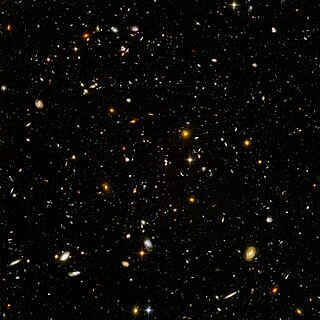
The universe is all of space and time and their contents, including planets, stars, galaxies, and all other forms of matter and energy. The Big Bang theory is the prevailing cosmological description of the development of the universe. According to this theory, space and time emerged together 13.787±0.020 billion years ago, and the universe has been expanding ever since the Big Bang. While the spatial size of the entire universe is unknown, it is possible to measure the size of the observable universe, which is approximately 93 billion light-years in diameter at the present day.
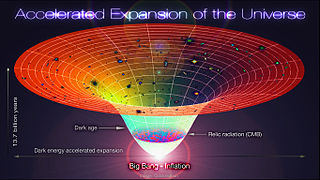
Observations show that the expansion of the universe is accelerating, such that the velocity at which a distant galaxy recedes from the observer is continuously increasing with time. The accelerated expansion of the universe was discovered during 1998 by two independent projects, the Supernova Cosmology Project and the High-Z Supernova Search Team, which both used distant type Ia supernovae to measure the acceleration. The idea was that as type Ia supernovae have almost the same intrinsic brightness, and since objects that are further away appear dimmer, we can use the observed brightness of these supernovae to measure the distance to them. The distance can then be compared to the supernovae's cosmological redshift, which measures how much the universe has expanded since the supernova occurred; the Hubble law established that the further an object is from us, the faster it is receding. The unexpected result was that objects in the universe are moving away from one another at an accelerated rate. Cosmologists at the time expected that recession velocity would always be decelerating, due to the gravitational attraction of the matter in the universe. Three members of these two groups have subsequently been awarded Nobel Prizes for their discovery. Confirmatory evidence has been found in baryon acoustic oscillations, and in analyses of the clustering of galaxies.

Brian Randolph Greene is an American theoretical physicist, mathematician, and string theorist. Greene was a physics professor at Cornell University from 1990–1995, and has been a professor at Columbia University since 1996 and chairman of the World Science Festival since co-founding it in 2008. Greene has worked on mirror symmetry, relating two different Calabi–Yau manifolds. He also described the flop transition, a mild form of topology change, showing that topology in string theory can change at the conifold point.

Lawrence Maxwell Krauss is an American theoretical physicist and cosmologist who previously taught at Arizona State University, Yale University, and Case Western Reserve University. He founded ASU's Origins Project in 2008 to investigate fundamental questions about the universe and served as the project's director.

Saul Perlmutter is a U.S. astrophysicist, a professor of physics at the University of California, Berkeley, where he holds the Franklin W. and Karen Weber Dabby Chair, and head of the International Supernova Cosmology Project at the Lawrence Berkeley National Laboratory. He is a member of both the American Academy of Arts & Sciences and the American Philosophical Society, and was elected a Fellow of the American Association for the Advancement of Science in 2003. He is also a member of the National Academy of Sciences. Perlmutter shared the 2006 Shaw Prize in Astronomy, the 2011 Nobel Prize in Physics, and the 2015 Breakthrough Prize in Fundamental Physics with Brian P. Schmidt and Adam Riess for providing evidence that the expansion of the universe is accelerating. Since 2021, he has been a member of the President’s Council of Advisors on Science and Technology (PCAST).

Cosmology is a branch of physics and metaphysics dealing with the nature of the universe. The term cosmology was first used in English in 1656 in Thomas Blount's Glossographia, and in 1731 taken up in Latin by German philosopher Christian Wolff, in Cosmologia Generalis. Religious or mythological cosmology is a body of beliefs based on mythological, religious, and esoteric literature and traditions of creation myths and eschatology. In the science of astronomy, cosmology is concerned with the study of the chronology of the universe.

Adam Guy Riess is an American astrophysicist and Bloomberg Distinguished Professor at Johns Hopkins University and the Space Telescope Science Institute. He is known for his research in using supernovae as cosmological probes. Riess shared both the 2006 Shaw Prize in Astronomy and the 2011 Nobel Prize in Physics with Saul Perlmutter and Brian P. Schmidt for providing evidence that the expansion of the universe is accelerating.

Sean Michael Carroll is an American theoretical physicist and philosopher who specializes in quantum mechanics, cosmology, and philosophy of science. Formerly a research professor in the Walter Burke Institute for Theoretical Physics in the California Institute of Technology (Caltech) Department of Physics, he is currently an External Professor at the Santa Fe Institute, and the Homewood Professor of Natural Philosophy at Johns Hopkins University. He has been a contributor to the physics blog Cosmic Variance, and has published in scientific journals such as Nature as well as other publications, including The New York Times, Sky & Telescope and New Scientist. He is known for his atheism, his vocal critique of theism and defense of naturalism. He is considered a prolific public speaker and science populariser. In 2007, Carroll was named NSF Distinguished Lecturer by the National Science Foundation.

Paul S. Wesson, B.Sc., Ph.D., D.Sc., F.R.A.S was a professor of astrophysics and theoretical physics. He was educated at the Universities of London and Cambridge in England, and spent most of his career at the University of Waterloo in Canada. He also spent sabbatical leaves at Berkeley and Stanford in California, and was associated in his later years with the Herzberg Institute of Astrophysics in Victoria, Canada. He supervised numerous graduate students and postdoctoral fellows and served as Science Director of the California Institute for Physics and Astronomy. His scientific interests were broad, ranging from a seismic survey of Afghanistan to guest lectures and media interviews on the Big Bang in America. He published over 300 works including nine textbooks and three science-fiction novels. Most of his articles appeared in the standard journals for astronomy and theoretical physics, but he also wrote pieces for New Scientist and other magazines of popular science. In later years, he characterized his research as concentrating on two subjects:
In physical cosmology and astronomy, dark energy is an unknown form of energy that affects the universe on the largest scales. The first observational evidence for its existence came from measurements of supernovas, which showed that the universe does not expand at a constant rate; rather, the universe's expansion is accelerating. Understanding the universe's evolution requires knowledge of its starting conditions and composition. Before these observations, scientists thought that all forms of matter and energy in the universe would only cause the expansion to slow down over time. Measurements of the cosmic microwave background (CMB) suggest the universe began in a hot Big Bang, from which general relativity explains its evolution and the subsequent large-scale motion. Without introducing a new form of energy, there was no way to explain an accelerating expansion of the universe. Since the 1990s, dark energy has been the most accepted premise to account for the accelerated expansion. As of 2021, there are active areas of cosmology research to understand the fundamental nature of dark energy. Assuming that the lambda-CDM model of cosmology is correct, as of 2013, the best current measurements indicate that dark energy contributes 68% of the total energy in the present-day observable universe. The mass–energy of dark matter and ordinary (baryonic) matter contributes 26% and 5%, respectively, and other components such as neutrinos and photons contribute a very small amount. Dark energy's density is very low: 6×10−10 J/m3 (~7×10−30 g/cm3), much less than the density of ordinary matter or dark matter within galaxies. However, it dominates the universe's mass–energy content because it is uniform across space.
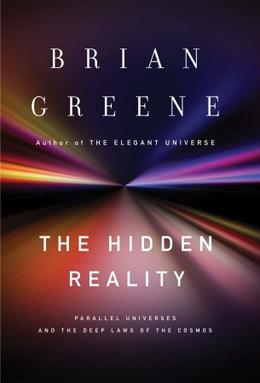
The Hidden Reality: Parallel Universes and the Deep Laws of the Cosmos is a book by Brian Greene published in 2011 which explores the concept of the multiverse and the possibility of parallel universes. It has been nominated for the Royal Society Winton Prize for Science Books for 2012.
John G. Hartnett, is an Australian young Earth creationist and cosmologist. He has been active with Creation Ministries International and is known for his opposition to the Big Bang theory and criticism of the dark matter and dark energy hypotheses.
Ethan R. Siegel is an American theoretical astrophysicist and science writer, who studies the Big Bang theory. In the past he has been a professor at Lewis & Clark College and a blogger at Starts With a Bang, on ScienceBlogs and also on Forbes.com since 2016.
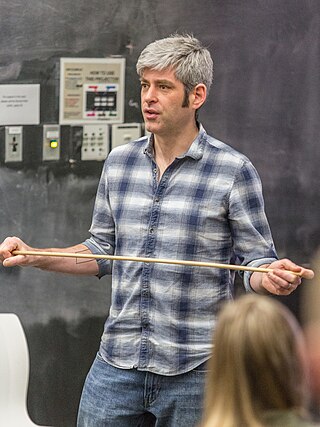
Daniel Wayne Hooper is an American cosmologist and particle physicist specializing in the areas of dark matter, cosmic rays, and neutrino astrophysics. He is a Senior Scientist at Fermi National Accelerator Laboratory and a Professor of Astronomy and Astrophysics at the University of Chicago.
Richard Panek is an American popular science writer, columnist, and journalist who specializes in the topics of space, the universe, and gravity. He has published several books and has written articles for a number of news outlets and scientific organizations, including Scientific American, WIRED, New Scientist, and Discover.
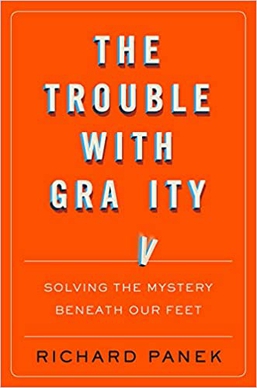
The Trouble With Gravity: Solving The Mystery Beneath Our Feet is a nonfiction popular science book by Richard Panek and published by Houghton Mifflin Harcourt on July 9, 2019.















